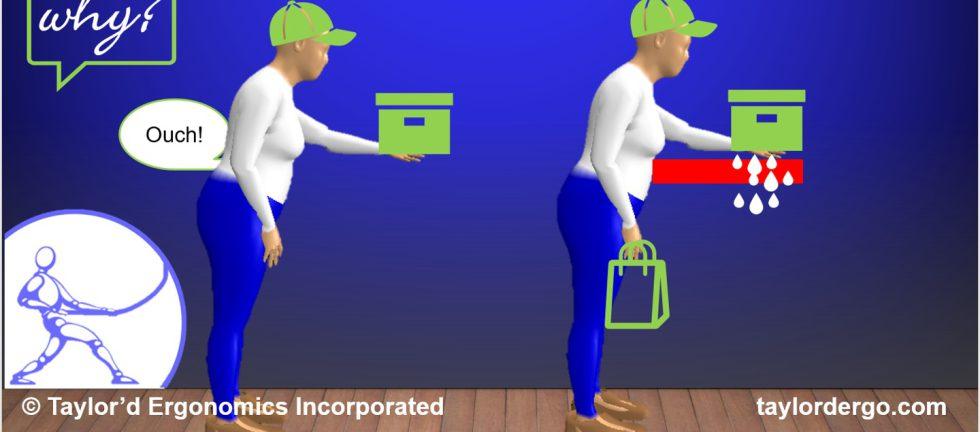We’ve all seen dozens of examples of people getting hurt doing things that, in hindsight, they knew they shouldn’t do. (I’m not a fan of the “funniest home videos”, but who hasn’t spent a half hour cringing AND chuckling at people’s mistakes?) When someone tells you they hurt their shoulder while lifting a really heavy load with one hand, while reaching forward, don’t you wonder, “Why did you do that?” Why do smart people do foolish things?
Why do people do any things?
Every task that you do, you learned at some point in your life. You might have been taught, or you might have figured it out on your own. When asked why people do things a certain way, we’re often told, “We’ve always done it that way.”
I’m reminded of a story about a woman who always cut her roasts in half and cooked them in separate pans because her mother and grandmother had done it that way. It turned out, her grandmother didn’t have a big enough roasting pan for a large roast.
In industry, examples abound:
- George lifts boxes from the bottom instead of the handles because, once, a faulty handle broke and spilled the contents of the box.
- Murray doesn’t use a new lift table because he is “used to” the old way. He has never been trained, or doesn’t have enough experience to be comfortable with the new device.
- Laurie was taught to hold the tool in her right hand and apply the trigger with the index finger, and she has never tried any other method.
- The image above represents a few physical reasons for people to reach and lift: heat sources, physical barriers, loads that drip and need to be held away from the body, or a requirement to hold something in the second hand.
When someone tells the story of how they hurt themselves, remember to really dig for the reason that the task was done that way. Smart people do things the way they have to in the circumstances, the way they were trained, or the way their experience has shown them to be the best way.
Why do people change the way they do things?
In my opinion, people are motivated to change their work methods by three things: speed, energy output, and pain.
Working faster or using less energy at work frequently causes us to do “dumb” things.
- If I lift 10 reams of paper at a time instead of 5, I will be able to go home 15 minutes earlier, arriving before my teenager gets off the bus.
- I am supposed to stand to pack small items into trays at a packing line. My feet and legs ache less if I sit on a wooden box that I found, even though it’s more awkward to work in a twisted position at shoulder height.
- A squat lift requires more energy than a stoop lift; your body knows this! Your brain knows that a squat is stronger than a stoop, but sometimes your body lacks the energy to carry it out, especially for light items.
Pain, on the other hand, can be a strong advocate for ergonomics. If my back hurts, I’m going to find a way to avoid bending forward when I lift. If my right arm hurts, I’ll give left-mousing a try. If my neck hurts, I’ll figure out how to adjust my monitor.
Why do people do (seemingly) foolish things?
People are smarter than they look! Here are some examples of techniques that might initially look awkward or “unergonomic”, but might offer a biomechanical advantage.
Golfer’s lift – Kicking one leg out to the back as you bend forward doesn’t always look graceful, but the golfer’s lift has a biomechanical advantage for light objects at low heights.
A one-handed lift can be easier on the body than a 2-handed lift in some circumstances, particularly when holding the item with two hands involves a long reach, an awkward gait, or a weird grip. Consider trying to carry a pail up a set of stairs with 2 hands.
Wonky grips. Remember how I said that pain is a motivator? When objects are really hard to grip, or the handles are sharp, pointy, hot, wet, cold or otherwise painful to hold, people will hold things in ways that are hard to make sense of by observing. These grips are not foolish – they are necessary. Of course, if we can improve the grip, we can improve the demands on the whole body.
The bottom line: there’s a reason for everything.
If you see someone doing something that looks “unergonomic”, ask why, rather than assuming you know a better way. Their technique might not be as foolish as it appears. You may need several “whys” to get to the root cause. If the reason truly is, “Because we’ve always done it this way” then you might look for an opportunity to improve working techniques.
Want to blitz your organization to find the best ways of doing things? Ask us about how we can select, train, and mentor an ergonomics intern this summer!
Did you enjoy this article? Sign up to receive an email with a link to our weekly blog, here.
Need ergo support? Contact Carrie@TaylordErgo.com or 519-623-7733
Want more training for employees at your organization? Register for a workshop, here, or contact Carrie to arrange for us come to you!


